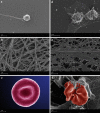Interplay between ultrastructural findings and atherothrombotic complications in type 2 diabetes mellitus
- PMID: 26228646
- PMCID: PMC4521497
- DOI: 10.1186/s12933-015-0261-9
Interplay between ultrastructural findings and atherothrombotic complications in type 2 diabetes mellitus
Abstract
Accelerated atherosclerosis is the main underlying factor contributing to the high risk of atherothrombotic events in patients with diabetes mellitus and atherothrombotic complications are the main cause of mortality. Like with many bodily systems, pathology is observed when the normal processes are exaggerated or uncontrolled. This applies to the processes of coagulation and thrombosis as well. In diabetes, in fact, the balance between prothrombotic and fibrinolytic factors is impaired and thus the scale is tipped towards a prothrombotic and hypofibrinolytic milieu, which in association with the vascular changes accompanying plaque formation and ruptures, increases the prevalence of ischaemic events such as angina and myocardial infarction. Apart from traditional, modifiable risk factors for cardiovascular disease like hypertension, smoking, elevated cholesterol; rheological properties, endogenous fibrinolysis and impaired platelet activity are rapidly gaining significance in the pathogenesis of atherosclerosis especially in diabetic subjects. Blood clot formation represents the last step in the athero-thrombotic process, and the structure of the fibrin network has a role in determining predisposition to cardiovascular disease. It is no surprise that just like platelets and fibrin networks, erythrocytes have been shown to play a role in coagulation as well. This is in striking contrast to their traditional physiological role of oxygen transport. In fact, emerging evidence suggests that erythrocytes enhance functional coagulation properties and platelet aggregation. Among the spectrum of haematological abnormalities in diabetes, erythrocyte aggregation and decreased deformability of erythrocytes predominate. More importantly, they are implicated in the pathogenesis of microvascular complications of diabetes. The morphology of platelets, fibrin networks and erythrocytes are thus essential role players in unravelling the pathogenesis of cardiovascular complications in diabetic subjects.
Figures


References
-
- Kluft C, Jespersen J. Review: diabetes as a procoagulant condition. Br J Diabetes Vasc Dis. 2002;2(5):358–362. doi: 10.1177/14746514020020050301. - DOI
Publication types
MeSH terms
Substances
LinkOut - more resources
Full Text Sources
Other Literature Sources
Medical

